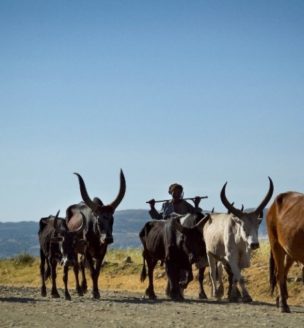
The Ethiopia Land Administration to Nurture Development (LAND) project is a 5-year project (2013-2018) working at the national and regional levels of government to further improve the legal and regulatory framework related to land tenure and property rights, thereby supporting the Government of Ethiopia’s and USAID’s goals of increasing economic growth, improving rural resiliency, and improving resource governance. The project works with pastoral communities in the Afar and Oromia regions of Ethiopia to support the formal recognition of customary land rights and strengthen the capacity of formal and customary pastoral land administration and land use institutions to engage in effective land and resource governance.
THE IMPACT EVALUATION DESIGN – AFAR
USAID is supporting a rigorous impact evaluation (IE) of the LAND project intervention in Afar to measure the key development impacts of project activities on communities and households related to enhancements in community resource governance, tenure security, climate resilience, and livelihoods, The IE will utilize a Difference-in-Difference methodology to measure impact, using baseline and endline evaluation data to compare changes over time between communities in Afar receiving the LAND intervention and communities in Afar that are not receiving the LAND intervention. Comprehensive quantitative and qualitative baseline data was collected prior to the start of LAND activities from March to June 2016. The IE data collection instruments were designed to collect information on the conditions of grazing areas and water points, tenure security and access to grazing areas and water points, and natural resource governance. Endline data collection and analysis is scheduled for early 2019.
THE IMPACT EVALUATION DESIGN – OROMIA
USAID is supporting a rigorous impact evaluation (IE) of the LAND project intervention in the Guji-Borana pastoral zone of Oromia. The IE is designed to measure the key development impacts of project activities on communities and households related to enhancements in community resource governance, tenure security, improved land governance institutions, better land use planning, and increased negotiation capacity. The IE will employ a Difference-in-Difference methodology to measure impact, using baseline and endline evaluation data to compare changes over time between communities in Oromia that are receiving the LAND intervention and are not receiving the LAND intervention. Comprehensive quantitative and qualitative baseline data was collected prior to the start of LAND activities in Oromia from August to October 2014. The IE data collection instruments were designed to collect information on livestock holdings and herding practices, access to farmland and land management practices, access to grazing land and water points, rangeland conditions, and resource-related disputes.
BY THE NUMBERS – AFAR
This evaluation will assess impacts at the household and community levels using five primary sources of data:
- 3000 Household Surveys;
- 1545 Wives Surveys, administered to wives in a subset of male-headed households;
- 263 Village Leader Surveys;
- 32 Focus Group Discussions, with women, youth, and agro-pastoralists;
- 128 Key Informant Interviews, with customary leaders and local government officials; and
- 50 Participatory Mapping Exercises, with herders and scouts.
BY THE NUMBERS – OROMIA
This evaluation will assess impacts at the household and community levels using five primary sources of data:
- 3800 Household Surveys;
- 80 Key Informant Interviews, with village leaders and individuals involved in rangeland management;
- 50 Participatory Mapping Exercises, with herders, village leaders, and community elders;
- 75 Focus Group Discussions, with women, agro-pastoralists, and resource-constrained individuals; and
- Administrative data on land expropriation and other materials to provide background context.
KEY BASELINE FINDINGS – AFAR
Baseline findings on the conditions of grazing areas and water points show that the conditions of both wet and dry season grazing areas in the study area are deteriorating due to consisted drought and the encroachment of invasive bush species. Baseline findings on governance in the study area indicate that customary leaders are primarily responsible for allocating land, setting and enforcing rules about land management, resolving conflicts, and decision-making regarding customary land use and management. Nonetheless, local expressions regarding governance reveal a perceived shift in the power and role of customary leaders over land use and rangeland management to formal government officials. In terms of tenure security, baseline findings on the threat of encroachment and risk of land reallocation of grazing areas indicate that respondents generally feel their land use and access rights are secure.
KEY BASELINE FINDINGS – OROMIA
The baseline findings reveal a study area undergoing rapid change. Continued bush encroachment and the expansion of human settlements and farming has reduced access to and use of rangelands. Although the Borana and Guji areas have experienced considerable conflict over land and boundaries in the past decade resulting in losses of human lives and the destruction of land, less than 10% of households surveyed indicated that they had experienced any land-related conflict in the past year. When conflicts did arise, the baseline results show that customary elders are more likely to handle relatively minor land and resource conflicts within an ethnic group, while larger-scale conflicts over administrative boundaries involving different ethnic groups are often taken to formal government offices for mediation and resolution. Nonetheless, customary institutions continue to play a key role in creating rules and regulations over land and water and imposing penalties in cases of rule infractions. Lastly, the baseline analysis identifies very little outside private sector investment in land in the study region; however, local people are increasingly aware of the prospect that investors might come to the area.

